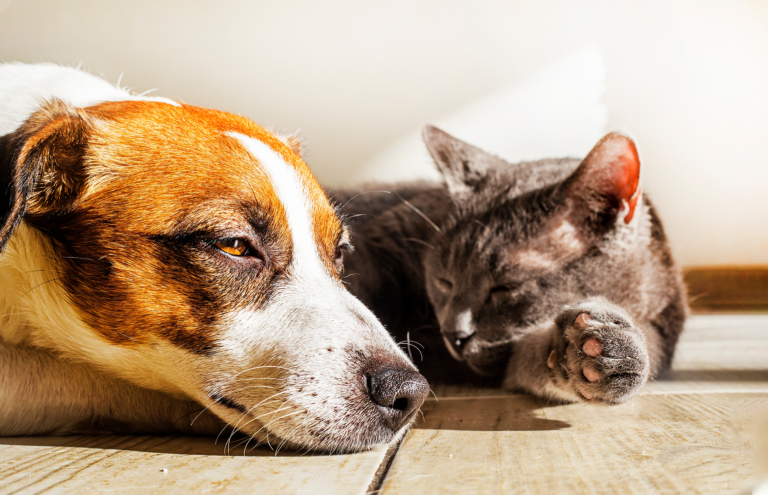Healthy Immune Function in Companion Animals
Healthy Immune Function in Companion Animals
The primary function of the immune system – in animals and humans alike – is to protect the body from infection and disease from bacteria, viruses, fungi, protozoa, parasites, and other harmful pathogens. The immune system is divided into two parts: innate and adaptive. Other important components of the immune response include lymphoid tissues of the skin, mucosa, nasal and respiratory passages, and gut.
The innate immune system is the initial defense against pathogens. It is non-specific; previous contact with a pathogen is not required, and the response is rapid: within minutes to hours. The adaptive immune system is specific and takes longer, from days to weeks, but the response is stronger the next time the body is exposed to the same pathogen. The products of acquired immunity can also assist innate immunity as well.
Lymphoid Tissues and the Immune System
Secondary lymphoid tissue is widely distributed throughout the periphery. This is where mature leukocytes and antigens interact and accumulate. Secondary lymphoid tissues include:
- Spleen
- Lymph nodes
- Skin-associated lymphoid tissue (SALT)
- Mucosa-associated lymphoid tissue (MALT)
The spleen is the major organ involved in trapping blood borne antigens and contains B and T cells, as well as macrophages. The spleen is able to make red blood cells and white blood cells if the bone marrow is compromised. Lymph nodes are the site for the collection and accumulation of antigens within the lymphatic system. They have an afferent (heading toward the central nervous system) lymphatic supply and efferent (heading away from the central nervous system) lymphatic drainage. SALT encounters and deals with antigens that try to penetrate the skin while MALT handles antigens that try to penetrate mucosal tissues. Subcategories of MALT include:
- Nasopharynx-associated lymphoid tissue (NALT)
- Bronchus-associated lymphoid tissue (BALT)
- Gut-associated lymphoid tissue (GALT)
The respiratory tract contains NALT and BALT, and it facilitates the protective physiological functions of coughing, sneezing, and the secretion of immunoglobulin A (IgA) into the mucus. Nasal passages are covered in mucus, which prevents particles greater than 15 microns from getting into the lungs; however, smaller particles may still affect the upper airways. Alveolar macrophages are active in the alveoli and engulf particles that are less than one micron, moving them up and out of the lungs.
About 70 percent of the immune system resides within the gastrointestinal (GI) tract. GALT protects the lining of the GI system and contains about 80 percent of the body’s plasma cells. The gastrointestinal tract has a mucosal barrier as well as normal gut microbes which prevent pathogens from adhering to the gut wall. Secretions of the GI tract also play a role in preventing and destroying microbes:
- Defensins (also known as cryptidins) have an antimicrobial function
- Lysozyme destroys bacterial walls
- Low pH of gastric secretions create an adverse environment for bacteria
- Physiological functions of vomiting and peristalsis help to eliminate pathogens
Skin provides an impermeable external barrier provided it is not compromised by excessive moisture or defects such as cuts, scrapes, or other breaks in the skin. The dermis and epidermis contain SALT as well as healthy microbes, which together inhibit the growth of other bacteria and produce antimicrobial products. Sebum, which coats the skin, contains long-chain fatty acids to keep the skin pH relatively low and prevents other bacteria from growing on the skin.
Within the urogenital tract, some epithelial secretions have antibacterial action. Urine helps to flush out pathogens, while its low pH helps to prevent the growth of bacteria. The shedding of the superficial epithelial of the bladder helps to reduce bacterial load. Within the genital tract, normal microbes help to inhibit the growth of other bacteria.
Animal Nutrition and the Immune System
A balanced nutritional plan is critical for an animal’s healthy immune system response. Malnutrition leads to impairment of cell mediated immunity, phagocyte function, complement system, secretory immunoglobulin, antibody concentrations, and cytokine production. However, over-nutrition and obesity also impair the immune system. Micronutrients are important to the immune system on multiple levels: vitamins A, C, and E and zinc are important to the maintenance of a physical barrier level; vitamins A, B6, B12, C, D, and E and folic acid, iron, zinc, copper, and selenium support cellular immunity; vitamins A, B6, B12, D, and E and folic acid, zinc, copper, and selenium support antibody production.
Potential Immune Stressors for Animals
The overall categories of potential immune stressors for animals include diet, medical treatments, and the physical environment a pet lives in. What constitutes an inappropriate diet is specific to each individual animal, and in many cases, to the pet parent and the veterinarian. Many veterinarians believe that a highly processed diet is not an optimum diet due to the destruction of heat labile nutrients, the production of harmful products such as advanced glycation end products, and, in some cases, the inclusion of harmful chemicals, contaminants such as aflatoxins, and poor quality of ingredients utilized in the making of the food. In some cases, an animal may have a dietary sensitivity or intolerance of which the pet parent is not aware. Pharmaceuticals, pesticides and other chemicals can all be immune system stressors; their impact varies depending upon the product and the status of the animal and can range from minimal to catastrophic. Vaccines may also be immune system stressors, though vaccines are also an important part of preventative healthcare for animals, such as protection from rabies and distemper.
Additionally, the physical environment in which an animal lives is often inappropriate. The local climate may be unsuitable and dangerous for some breeds of dogs and cats. Brachycephalic (short nose and flat face; Pugs, Shih Tzus, Chihuahuas, etc.) dogs and cats have increased respiratory difficulty in hot climates while hairless to short-coated animals may be challenged by a climate where snowfall and ice are common, especially if the pet is left outdoors. Some animals require a fair amount of territory and space, so a small home or apartment may not be appropriate. In some cases, an animal may wish to be solitary while other animals may be “pack” animals and benefit considerably from living with other furry friends. The addition of a new family member (two- or four-legged) may be stressful for the existing animals as the new addition may not be compatible due to activity level, lack of space, and/or personality and temperament. Additionally, many companion animals do not receive sufficient physical and mental stimulation and activity, which may be a potential immune stressor.
The Actively Maturing Animal Immune System
The amount of maternally derived antibodies (MDAs) that are present in neonates is difficult to predict, as the quantity depends upon the mother and the amount of colostrum that the neonate has ingested. MDAs decline at a variable rate from birth to about three months; most MDAs are gone by 14 to 16 weeks of age. Serum MDA interferes with immunization as it inhibits IgG production via a negative feedback system and neutralizes vaccine antigens, thereby preventing an immune response. Thus, early vaccination may not benefit puppies and kittens. Puppies are considered to be most vulnerable to infectious diseases at about 10 to 14 weeks of age, while kittens may be susceptible to infectious diseases earlier than puppies, possibly by two weeks. Running titers for certain diseases may help to determine the optimal time to start vaccination by identifying when MDAs are low; however, the stress of repeated venipuncture may outweigh the possible health benefits.
Other stressors that puppies and kittens experience include being separated from their mothers and littermates and then being placed in a totally new environment where they are exposed to new sets of pathogens. There are also different sights, sounds, and smells and exposure to other animals, both domestic and wild. Everything is “new” and their world becomes a host of new pathogens, experiences, stimuli (some which are scary), and active learning.
Animal Immune Stress from Adolescence to Adulthood
Around adolescence, the thymus gland starts to shrink, but the consequences of this gradual decline do not seem to have a significant impact until later in life. There is often more exposure to other humans and animals outside of the family as pet parents may bring their animals to training classes, competitions/shows/events, pet stores, and other public places such as parks and outdoor dining venues. Dogs that participate in special dog events (both recreational and competitive) will likely be exposed to diseases and pathogens that are not endemic to their home locale due to the event location and participants from other areas. Additionally, some animals experience stress from traveling and from the actual competition itself. Breeding adults have the additional stress of circulating sex hormones which create physical and behavioral changes. Sex hormones also play a regulatory role in the immune system. Pregnancy and nursing are stressful and consume extra energy and resources from the mother. Often the mother experiences distress when her young are (permanently) removed from her care.
The Geriatric Animal Immune System
With age, the components of the innate and adaptive immune systems are adversely affected, thereby causing an overall decline of immune system function. By the time an animal is geriatric, the thymus gland has mostly been replaced by fat, which results in the reduced output of naïve T cells. Splenic-senile atrophy may also occur, resulting in thickening in tissue support frameworks, as well as markedly reduced red and white pulp. In humans, the aged population has an increased vulnerability to infection, poor response to vaccination and an increased incidence of autoimmunity. Similar changes have been recognized in dogs and cats as well.
The immune system is a complex network of organs, tissues, cells, proteins, and chemicals which, along with the other parts of the body, matures and declines with age. Reducing stress, feeding a biologically appropriate diet, and providing a healthy environment for pets is fundamental to creating and maintaining a healthy immune system. A healthy immune system provides companion animals the best opportunity for a healthy, vibrant, and long life.
- Bhatia A, Sekhon HK, Kaur G. Sex hormones and immune dimorphism. ScientificWorldJournal. 2014;2014:159150. doi: 10.1155/2014/159150. Epub 2014 Nov 17. PMID: 25478584; PMCID: PMC4251360.
- Chandra RK. Nutrition and the immune system: an introduction. Am J Clin Nutr. 1997 Aug;66(2):460S-463S. doi: 10.1093/ajcn/66.2.460S. PMID: 9250133.
- Drjeandoddspethealthresource. (2017, October 29). AAHA Vaccination Guidelines 2017 for Dogs Review. Dr. Jean Dodds’ Pet Health Resource Blog. https://drjeandoddspethealthresource.tumblr.com/post/166919932761/aaha-vaccination-guidelines-2017-for-dogs-review#.YJIL6bVKhaQ.
- Gombart AF, Pierre A, Maggini S. A Review of Micronutrients and the Immune System-Working in Harmony to Reduce the Risk of Infection. Nutrients. 2020 Jan 16;12(1):236. doi: 10.3390/nu12010236. PMID: 31963293; PMCID: PMC7019735.
- Nutrition and Immunity. The Nutrition Source. (2021, January 27). https://www.hsph.harvard.edu/nutritionsource/nutrition-and-immunity/.
- Stone, Amy E.S., Brummet, Gary O., Carozza, Ellen M., et al. (2020). 2020 AAHA/AAFP Feline Vaccination Guidelines. American Animal Hospital Association, American Association of Feline Practitioners, and International Society of Feline Medicine. 56:249-265. DOI 10.5326/JAAHA-MS-7123.
- Taneja V. Sex Hormones Determine Immune Response. (2018). Front Immunol. 27;9:1931. doi: 10.3389/fimmu.2018.01931. PMID: 30210492; PMCID: PMC6119719.







